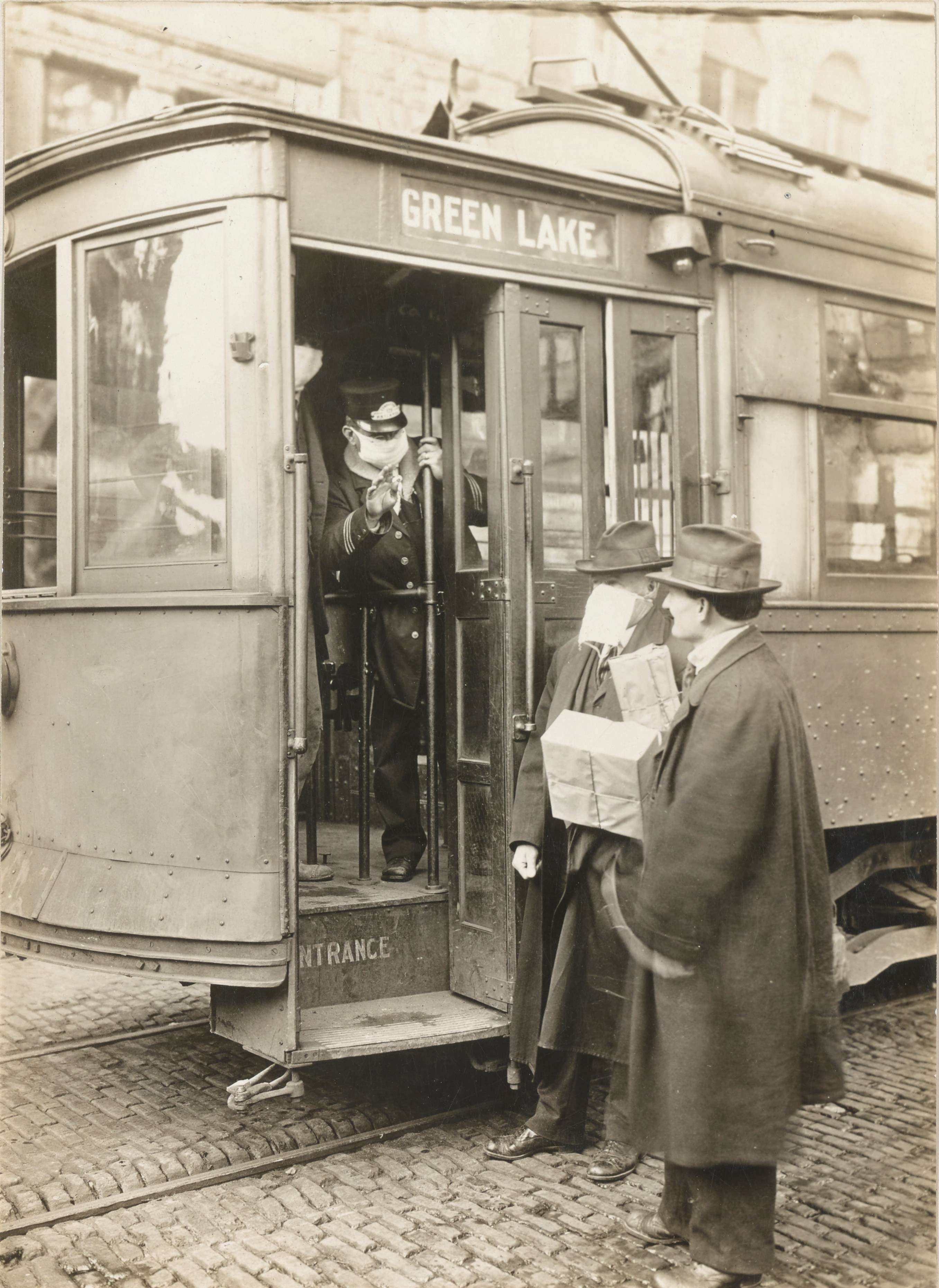Aspects of World War I: Spanish Flu
Seeing the Big Picture
All documents and text associated with this activity are printed below, followed by a worksheet for student responses.Introduction
The Spanish Flu outbreak of 1918, is ranked as one of the deadliest epidemics in history. It is estimated to have killed more than 50 million people worldwide. It broke out near the end of World War I, and killed more people than did the War.Activity Instructions:
Match each primary source to its description. As you make the match, study each document thoroughly. For texts, ask yourself the following questions: 1) Who wrote the text? 2) Where did the text originate? 3) What are the important points that the text is trying to convey? For photographs, ask yourself the following questions: 1) What is happening in the photo? 2) What point is the photo trying to make? 3) If there are people in the photo, what is their mood and why do you think this is?
Other questions to consider:
1) Is medical advice from this era the same as today?
2) How did the Spanish Flu get its name?
3) Do you think this flu had an effect on the War? Why or why not?
4) How do you think this epidemic affected children of this time?
After successful completion of this activity, a picture will be revealed. This picture will represent another aspect of the Spanish Flu outbreak which offers the opportunity for further discovery.
Name:
Class:
Class:
Worksheet
Aspects of World War I: Spanish Flu
Seeing the Big Picture
Examine the documents and text included in this activity. Consider how each document or piece of text relates to each other and create matched pairs. Write the text or document number next to its match below. Write your conclusion response in the space provided.1
2
3
4
5
6
7
8
9
10
11
12
1
Activity Element

2
Activity Element
Red Cross Workers Making Anti-Influenza Masks; May 12, 1919
3
Activity Element
Flu Serum Injection, Seattle Washington; December 1918
4
Activity Element
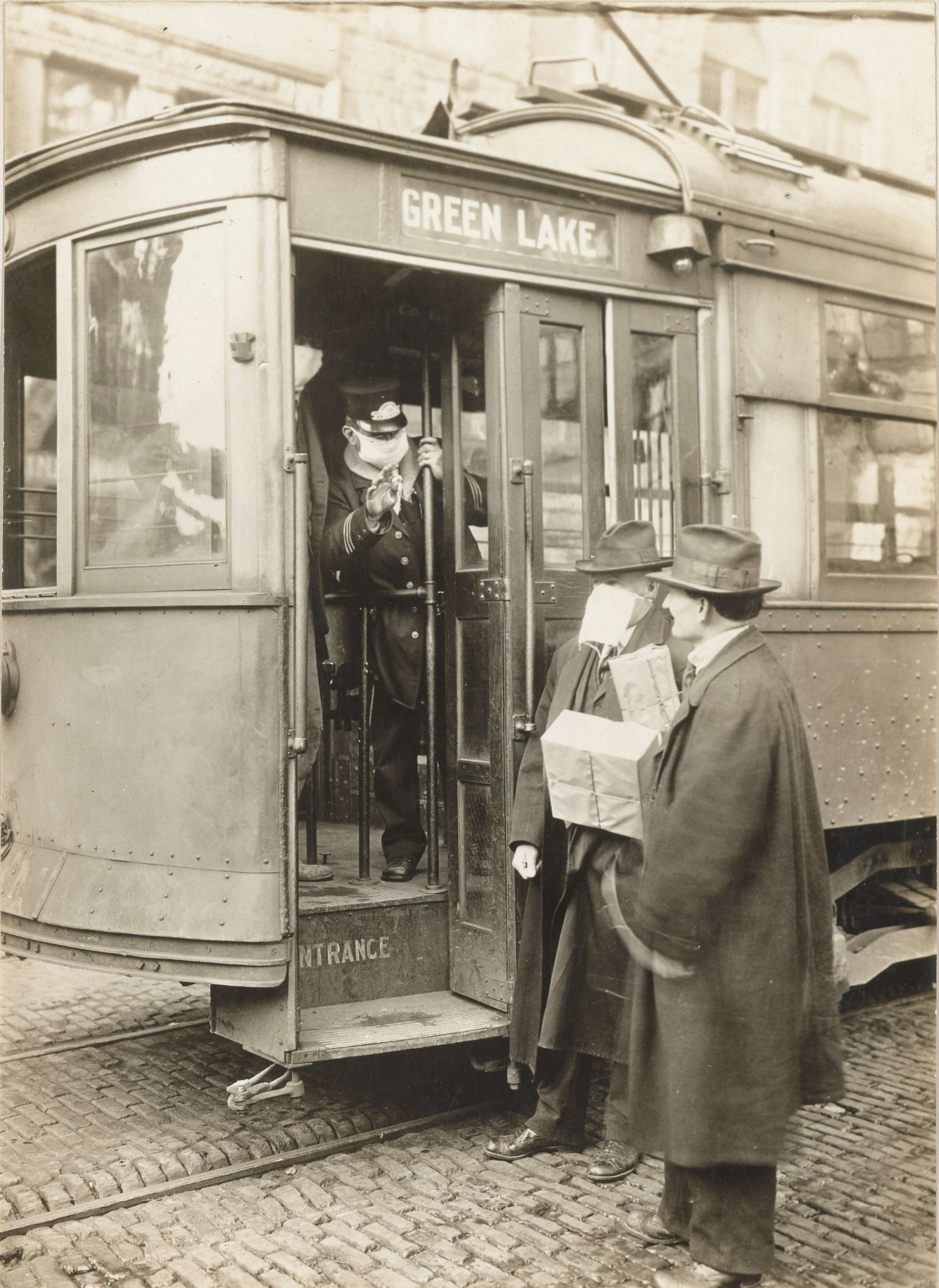
5
Activity Element
Emergency Hospital at Brookline, Massachusetts for Influenza Patients; October, 1918
6
Activity Element
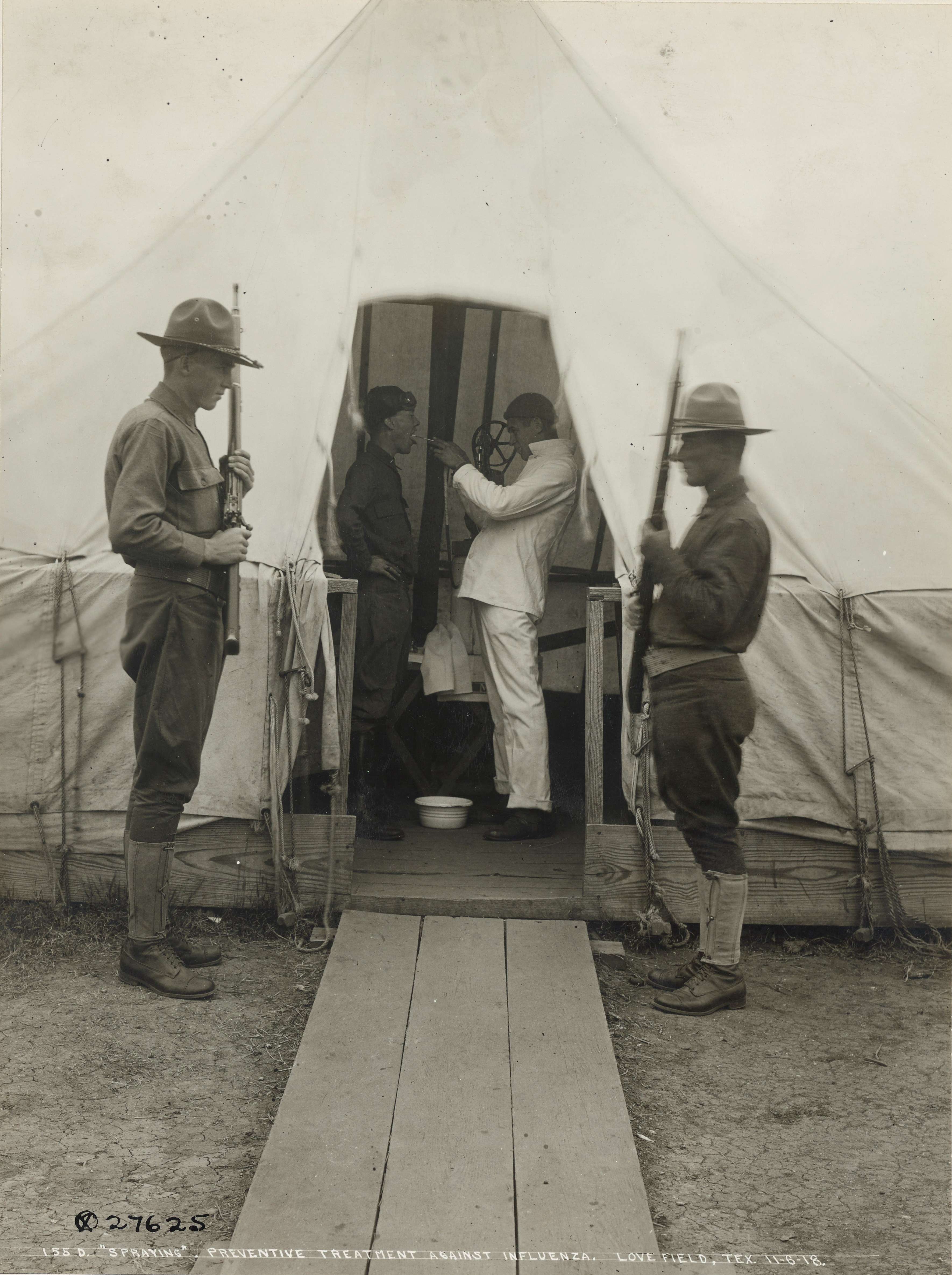
7
Activity Element

8
Activity Element
Spraying the Throat Against Influenza in Dallas, TX; 1917-1918
9
Activity Element

10
Activity Element

11
Activity Element
Letter From Harry S. Truman to Bess Wallace; January 21, 1919
12
Activity Element
Police Court in San Francisco Holding Session in the Open to Prevent the Spread of Influenza; November 29, 1918
13
Activity Element
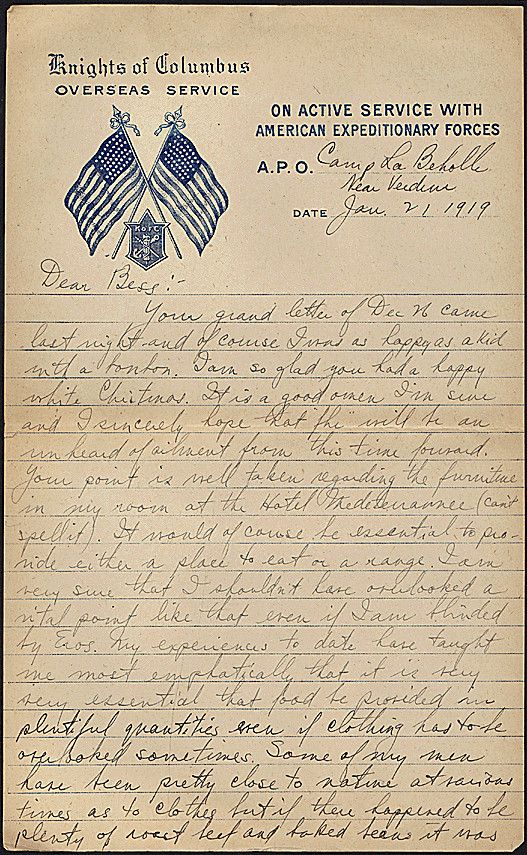
14
Activity Element
Policemen in Seattle, Washington Wearing Masks During the Influenza Epidemic; December 1918
15
Activity Element
Red Cross Canteens tending to Sick Families; 1917-1919
16
Activity Element
Seattle, Washington Requiring Street Car Passengers to Wear Masks During the Influenza Epidemic; December 1918
17
Activity Element

18
Activity Element
Warning Poster in Trolley Car; November 8, 1918
19
Activity Element
Letter From Lutiant Van Wert to Louise; October 17, 1918
20
Activity Element

21
Activity Element

22
Activity Element

23
Activity Element
Flyer With Precautions to Take Against Influenza; February 3, 1920
24
Activity Element
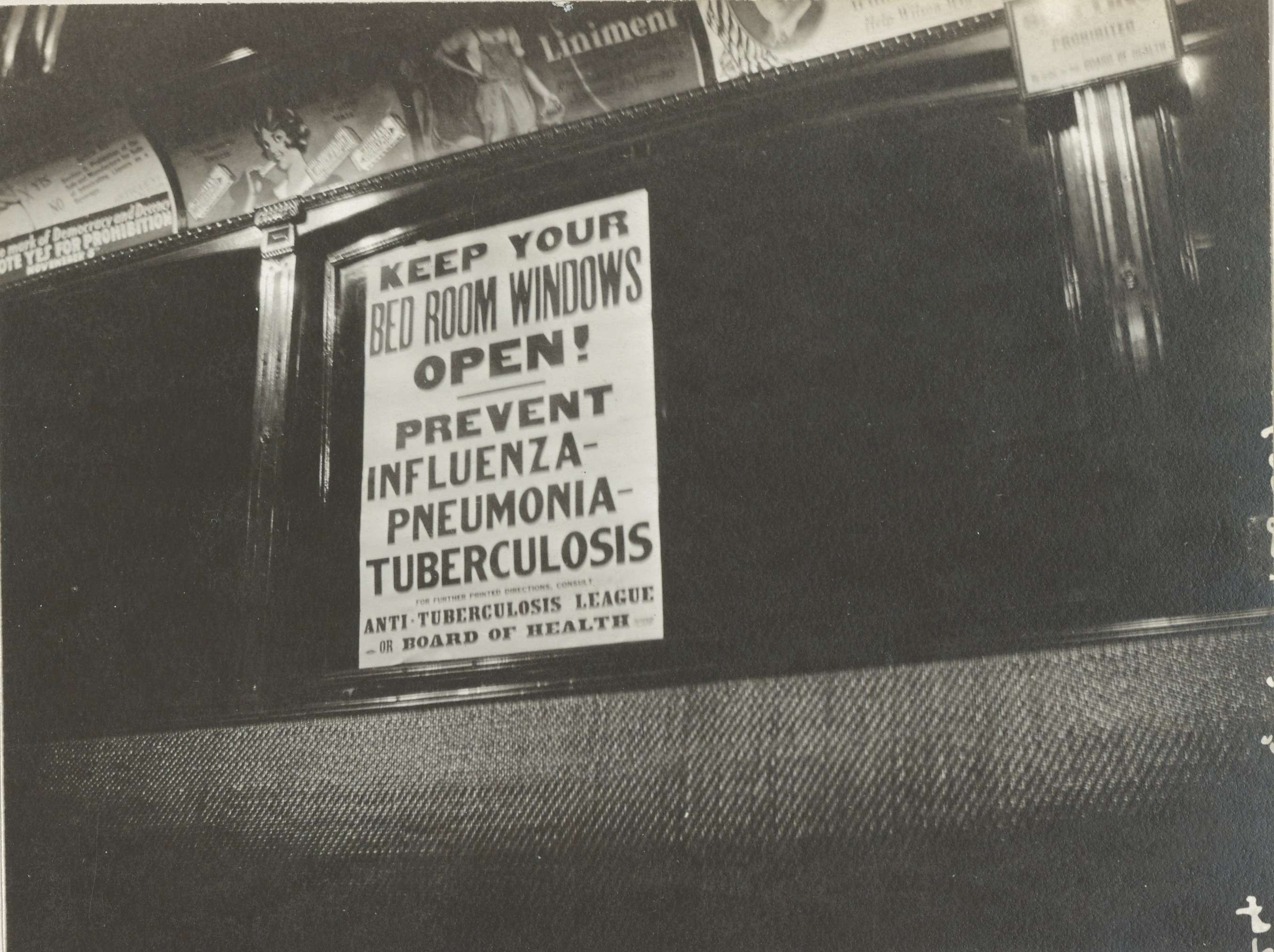
Culminating Document
Full Citation: . [Online Version, https://www.docsteach.org/documents/document/, April 25, 2024]
Conclusion
Aspects of World War I: Spanish Flu
Seeing the Big Picture
Once the final picture is revealed, ask yourself the following questions:1) What place or places are shown on the map?
2) Why do you think this map was created?
3) What does the map reveal?
4) What do the colors on the map stand for?
5) What are the labels on the map?
6) If you were to write a three sentence description of the map, how would it read?
Your Response
Document
Precautions Against Influenza
2/3/1920
This flyer warned naval employees to take precautions against the contraction and spread of influenza.
This primary source comes from the Records of Naval Districts and Shore Establishments.
National Archives Identifier: 6861947
Full Citation: Precautions Against Influenza; 2/3/1920; General Correspondence, ca. 1915 - 1925; Records of Naval Districts and Shore Establishments, ; National Archives at Boston, Waltham, MA. [Online Version, https://www.docsteach.org/documents/document/precautions-against-influenza, April 25, 2024]Precautions Against Influenza
Page 1
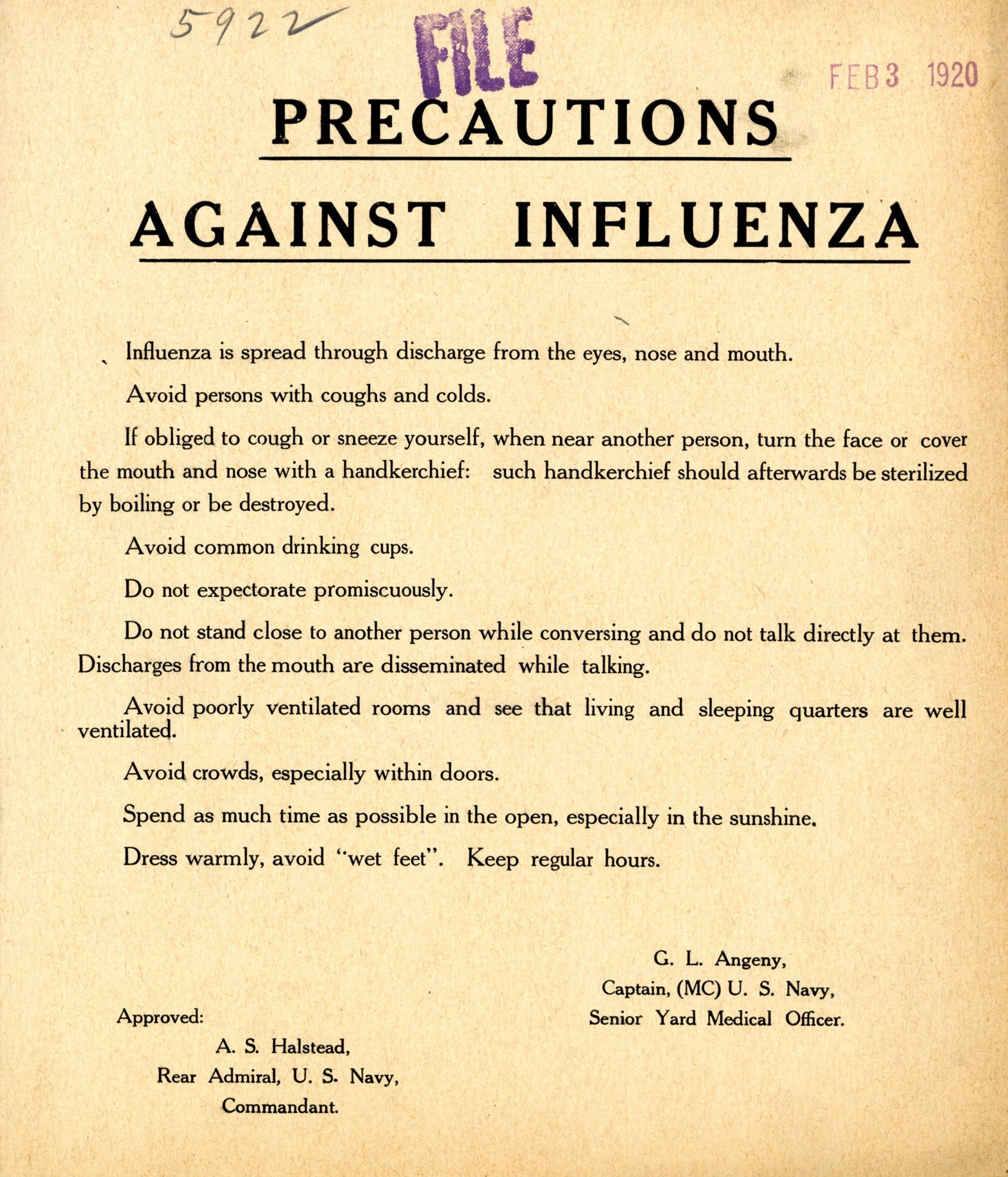
Document
Medical Department - Influenza Epidemic 1918 - Fighting influenza in Seattle. Flu serum injection, Seattle, Washington
12/1918
This photograph shows the fight against influenza with flu serum injections in Seattle, Washington.
The 1918 Influenza Pandemic, also known as the Spanish Flu, was one of the deadliest events in human history. One fifth of the world's population was attacked. The epidemic killed an estimated 50 million people around the world – more than died in World War I. Within months, the deadly flu virus had killed more people than any other illness in recorded history.
Scientists, doctors, and health officials could not identify this disease which was striking so fast and so viciously, eluding treatment and defying control. Some victims died within hours of their first symptoms. Others succumbed after a few days; their lungs filled with fluid and they suffocated to death. The flu did not discriminate. It was rampant in urban and rural areas, from the densely populated East coast to the remotest parts of Alaska. Young adults, usually unaffected by these types of infectious diseases, were among the hardest hit groups along with the elderly and young children. The flu afflicted over 25 percent of the U.S. population.
The 1918 Influenza Pandemic, also known as the Spanish Flu, was one of the deadliest events in human history. One fifth of the world's population was attacked. The epidemic killed an estimated 50 million people around the world – more than died in World War I. Within months, the deadly flu virus had killed more people than any other illness in recorded history.
Scientists, doctors, and health officials could not identify this disease which was striking so fast and so viciously, eluding treatment and defying control. Some victims died within hours of their first symptoms. Others succumbed after a few days; their lungs filled with fluid and they suffocated to death. The flu did not discriminate. It was rampant in urban and rural areas, from the densely populated East coast to the remotest parts of Alaska. Young adults, usually unaffected by these types of infectious diseases, were among the hardest hit groups along with the elderly and young children. The flu afflicted over 25 percent of the U.S. population.
This primary source comes from the Records of the War Department General and Special Staffs.
National Archives Identifier: 45499307
Full Citation: Photograph 165-WW-269B-9; Medical Department - Influenza Epidemic 1918 - Fighting influenza in Seattle. Flu serum injection, Seattle, Washington; 12/1918; Medical Department - Influenza Epidemic 1918; American Unofficial Collection of World War I Photographs, 1917 - 1918; Records of the War Department General and Special Staffs, ; National Archives at College Park, College Park, MD. [Online Version, https://www.docsteach.org/documents/document/flu-serum-injection-seattle-washington, April 25, 2024]Medical Department - Influenza Epidemic 1918 - Fighting influenza in Seattle. Flu serum injection, Seattle, Washington
Page 1
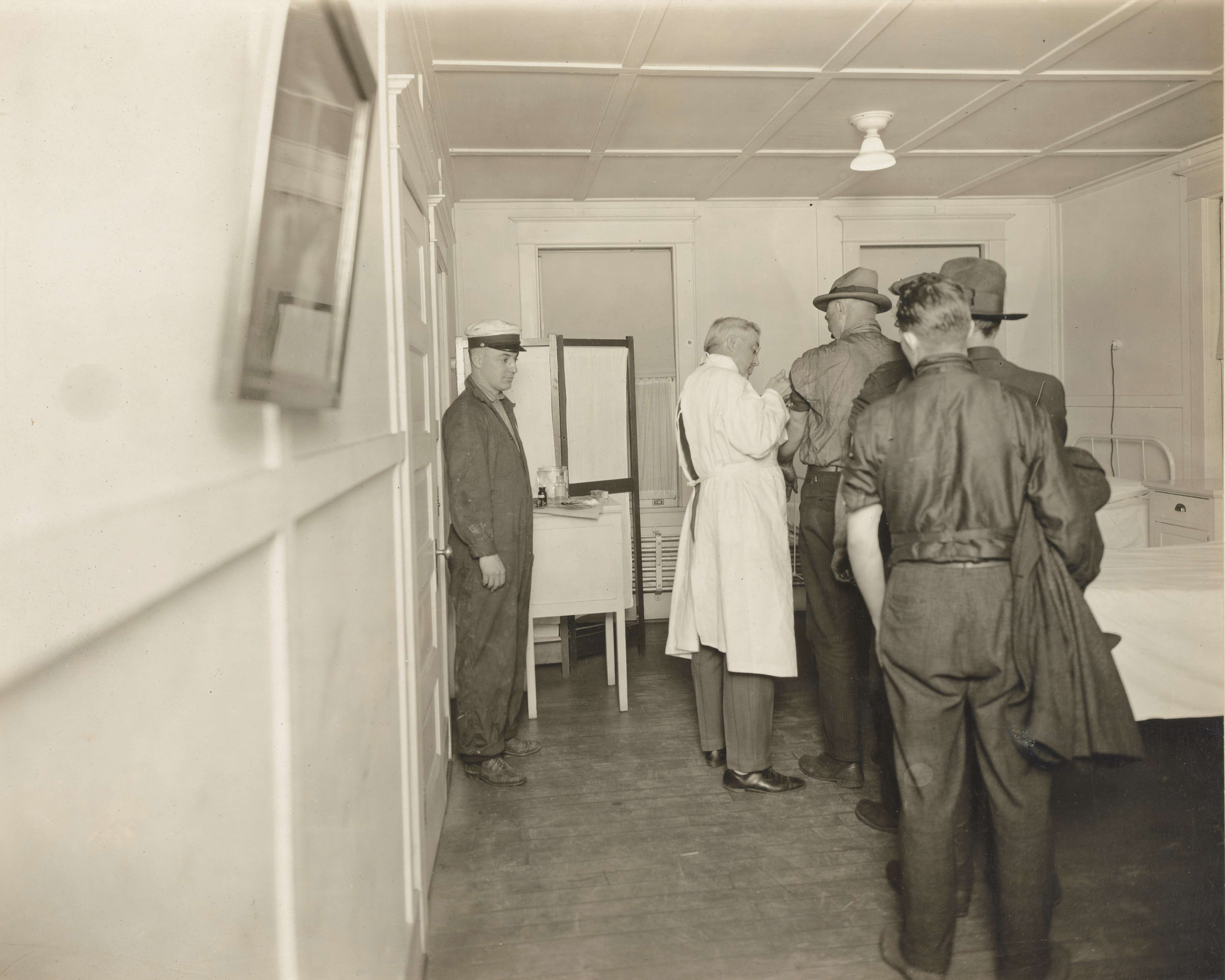
Document
Medical Department - Influenza Epidemic 1918 - Policemen in Seattle, Washington, wearing masks made by the Seattle Chapter of the Red Cross, during the influenza epidemic
12/1918
This photograph shows policemen in Seattle, Washington wearing masks made by the Seattle Chapter of the Red Cross during the influenza epidemic.
The 1918 Influenza Pandemic, also known as the Spanish Flu, was one of the deadliest events in human history. One fifth of the world's population was attacked. The epidemic killed an estimated 50 million people around the world – more than died in World War I. Within months, the deadly flu virus had killed more people than any other illness in recorded history.
Scientists, doctors, and health officials could not identify this disease which was striking so fast and so viciously, eluding treatment and defying control. Some victims died within hours of their first symptoms. Others succumbed after a few days; their lungs filled with fluid and they suffocated to death. The flu did not discriminate. It was rampant in urban and rural areas, from the densely populated East coast to the remotest parts of Alaska. Young adults, usually unaffected by these types of infectious diseases, were among the hardest hit groups along with the elderly and young children. The flu afflicted over 25 percent of the U.S. population.
The 1918 Influenza Pandemic, also known as the Spanish Flu, was one of the deadliest events in human history. One fifth of the world's population was attacked. The epidemic killed an estimated 50 million people around the world – more than died in World War I. Within months, the deadly flu virus had killed more people than any other illness in recorded history.
Scientists, doctors, and health officials could not identify this disease which was striking so fast and so viciously, eluding treatment and defying control. Some victims died within hours of their first symptoms. Others succumbed after a few days; their lungs filled with fluid and they suffocated to death. The flu did not discriminate. It was rampant in urban and rural areas, from the densely populated East coast to the remotest parts of Alaska. Young adults, usually unaffected by these types of infectious diseases, were among the hardest hit groups along with the elderly and young children. The flu afflicted over 25 percent of the U.S. population.
This primary source comes from the Records of the War Department General and Special Staffs.
National Archives Identifier: 45499339
Full Citation: Photograph 165-WW-269B-25; Medical Department - Influenza Epidemic 1918 - Policemen in Seattle, Washington, wearing masks made by the Seattle Chapter of the Red Cross, during the influenza epidemic; 12/1918; Medical Department - Influenza Epidemic 1918; American Unofficial Collection of World War I Photographs, 1917 - 1918; Records of the War Department General and Special Staffs, ; National Archives at College Park, College Park, MD. [Online Version, https://www.docsteach.org/documents/document/policemen-seattle-washington-masks-influenza, April 25, 2024]Medical Department - Influenza Epidemic 1918 - Policemen in Seattle, Washington, wearing masks made by the Seattle Chapter of the Red Cross, during the influenza epidemic
Page 1

Document
Medical Department - Influenza Epidemic 1918 - Police Court in open air- influenza prevention. Police Court Officials of San Francisco holding a session in the open, as a precaution against the spreading influenza epidemic
11/29/1918
This photograph shows the Police Court Officials of San Francisco holding a session in the open, as a precaution against the spreading influenza epidemic.
The 1918 Influenza Pandemic, also known as the Spanish Flu, was one of the deadliest events in human history. One fifth of the world's population was attacked. The epidemic killed an estimated 50 million people around the world – more than died in World War I. Within months, the deadly flu virus had killed more people than any other illness in recorded history.
Scientists, doctors, and health officials could not identify this disease which was striking so fast and so viciously, eluding treatment and defying control. Some victims died within hours of their first symptoms. Others succumbed after a few days; their lungs filled with fluid and they suffocated to death. The flu did not discriminate. It was rampant in urban and rural areas, from the densely populated East coast to the remotest parts of Alaska. Young adults, usually unaffected by these types of infectious diseases, were among the hardest hit groups along with the elderly and young children. The flu afflicted over 25 percent of the U.S. population.
The 1918 Influenza Pandemic, also known as the Spanish Flu, was one of the deadliest events in human history. One fifth of the world's population was attacked. The epidemic killed an estimated 50 million people around the world – more than died in World War I. Within months, the deadly flu virus had killed more people than any other illness in recorded history.
Scientists, doctors, and health officials could not identify this disease which was striking so fast and so viciously, eluding treatment and defying control. Some victims died within hours of their first symptoms. Others succumbed after a few days; their lungs filled with fluid and they suffocated to death. The flu did not discriminate. It was rampant in urban and rural areas, from the densely populated East coast to the remotest parts of Alaska. Young adults, usually unaffected by these types of infectious diseases, were among the hardest hit groups along with the elderly and young children. The flu afflicted over 25 percent of the U.S. population.
This primary source comes from the Records of the War Department General and Special Staffs.
National Archives Identifier: 45499315
Full Citation: Photograph 165-WW-269B-13; Medical Department - Influenza Epidemic 1918 - Police Court in open air- influenza prevention. Police Court Officials of San Francisco holding a session in the open, as a precaution against the spreading influenza epidemic; 11/29/1918; Medical Department - Influenza Epidemic 1918; American Unofficial Collection of World War I Photographs, 1917 - 1918; Records of the War Department General and Special Staffs, ; National Archives at College Park, College Park, MD. [Online Version, https://www.docsteach.org/documents/document/police-court-san-francisco-session-open-prevent-spread-influenza, April 25, 2024]Medical Department - Influenza Epidemic 1918 - Police Court in open air- influenza prevention. Police Court Officials of San Francisco holding a session in the open, as a precaution against the spreading influenza epidemic
Page 1
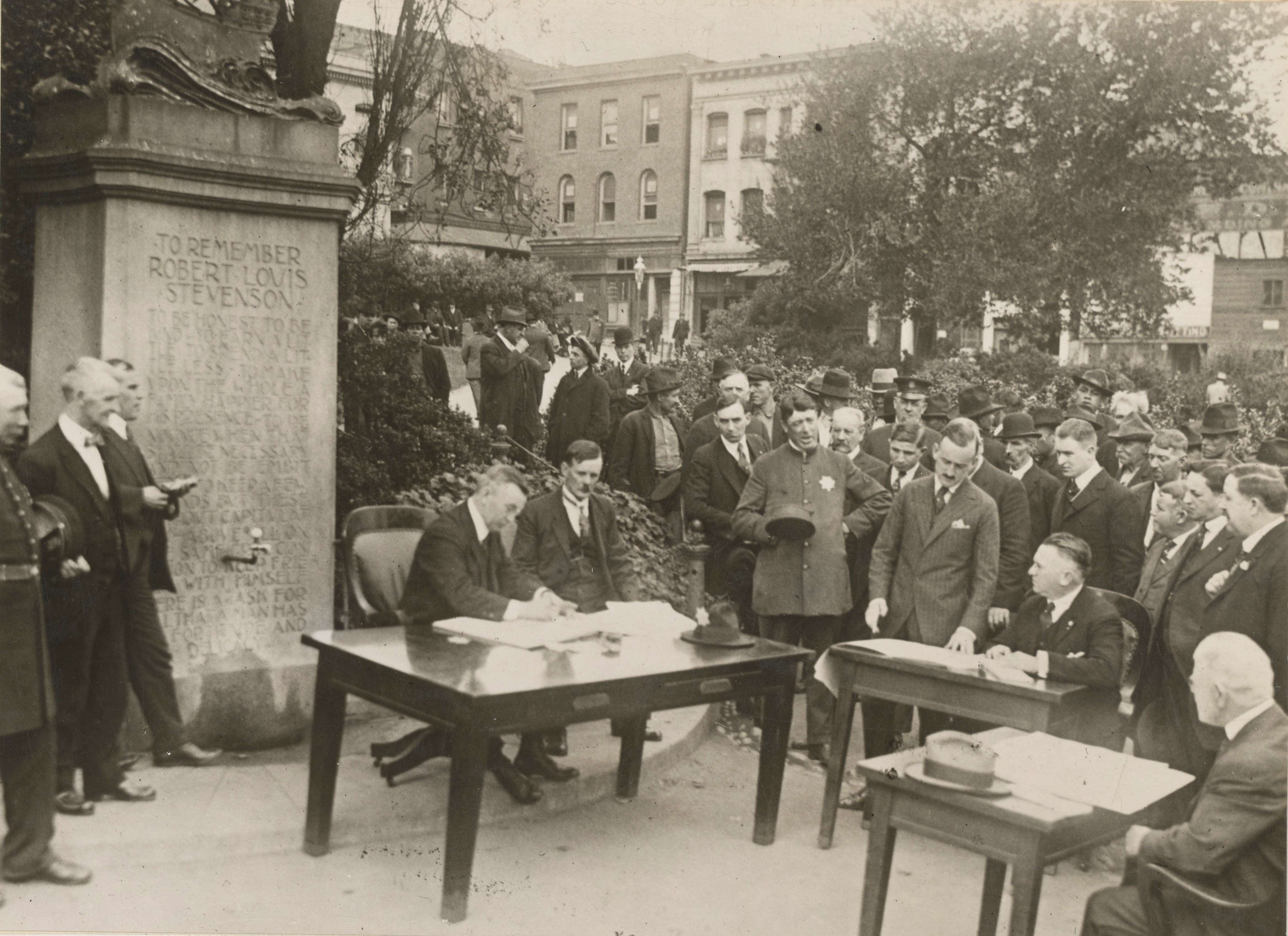
Document
Medical Department - Influenza Epidemic 1918 - Masks for protection against influenza. Red Cross workers making anti-influenza masks for soldiers in camp. Boston, Massachusetts
5/12/19
This photograph shows Red Cross workers making anti-influenza masks for soldiers in camp in Boston, Massachusetts.
The 1918 Influenza Pandemic, also known as the Spanish Flu, was one of the deadliest events in human history. One fifth of the world's population was attacked. The epidemic killed an estimated 50 million people around the world – more than died in World War I. Within months, the deadly flu virus had killed more people than any other illness in recorded history.
Scientists, doctors, and health officials could not identify this disease which was striking so fast and so viciously, eluding treatment and defying control. Some victims died within hours of their first symptoms. Others succumbed after a few days; their lungs filled with fluid and they suffocated to death. The flu did not discriminate. It was rampant in urban and rural areas, from the densely populated East coast to the remotest parts of Alaska. Young adults, usually unaffected by these types of infectious diseases, were among the hardest hit groups along with the elderly and young children. The flu afflicted over 25 percent of the U.S. population.
The 1918 Influenza Pandemic, also known as the Spanish Flu, was one of the deadliest events in human history. One fifth of the world's population was attacked. The epidemic killed an estimated 50 million people around the world – more than died in World War I. Within months, the deadly flu virus had killed more people than any other illness in recorded history.
Scientists, doctors, and health officials could not identify this disease which was striking so fast and so viciously, eluding treatment and defying control. Some victims died within hours of their first symptoms. Others succumbed after a few days; their lungs filled with fluid and they suffocated to death. The flu did not discriminate. It was rampant in urban and rural areas, from the densely populated East coast to the remotest parts of Alaska. Young adults, usually unaffected by these types of infectious diseases, were among the hardest hit groups along with the elderly and young children. The flu afflicted over 25 percent of the U.S. population.
This primary source comes from the Records of the War Department General and Special Staffs.
National Archives Identifier: 45499341
Full Citation: Photograph 165-WW-269B-26; Medical Department - Influenza Epidemic 1918 - Masks for protection against influenza. Red Cross workers making anti-influenza masks for soldiers in camp. Boston, Massachusetts; 5/12/19; Medical Department - Influenza Epidemic 1918; American Unofficial Collection of World War I Photographs, 1917 - 1918; Records of the War Department General and Special Staffs, ; National Archives at College Park, College Park, MD. [Online Version, https://www.docsteach.org/documents/document/red-cross-anti-influenza-mask, April 25, 2024]Medical Department - Influenza Epidemic 1918 - Masks for protection against influenza. Red Cross workers making anti-influenza masks for soldiers in camp. Boston, Massachusetts
Page 1
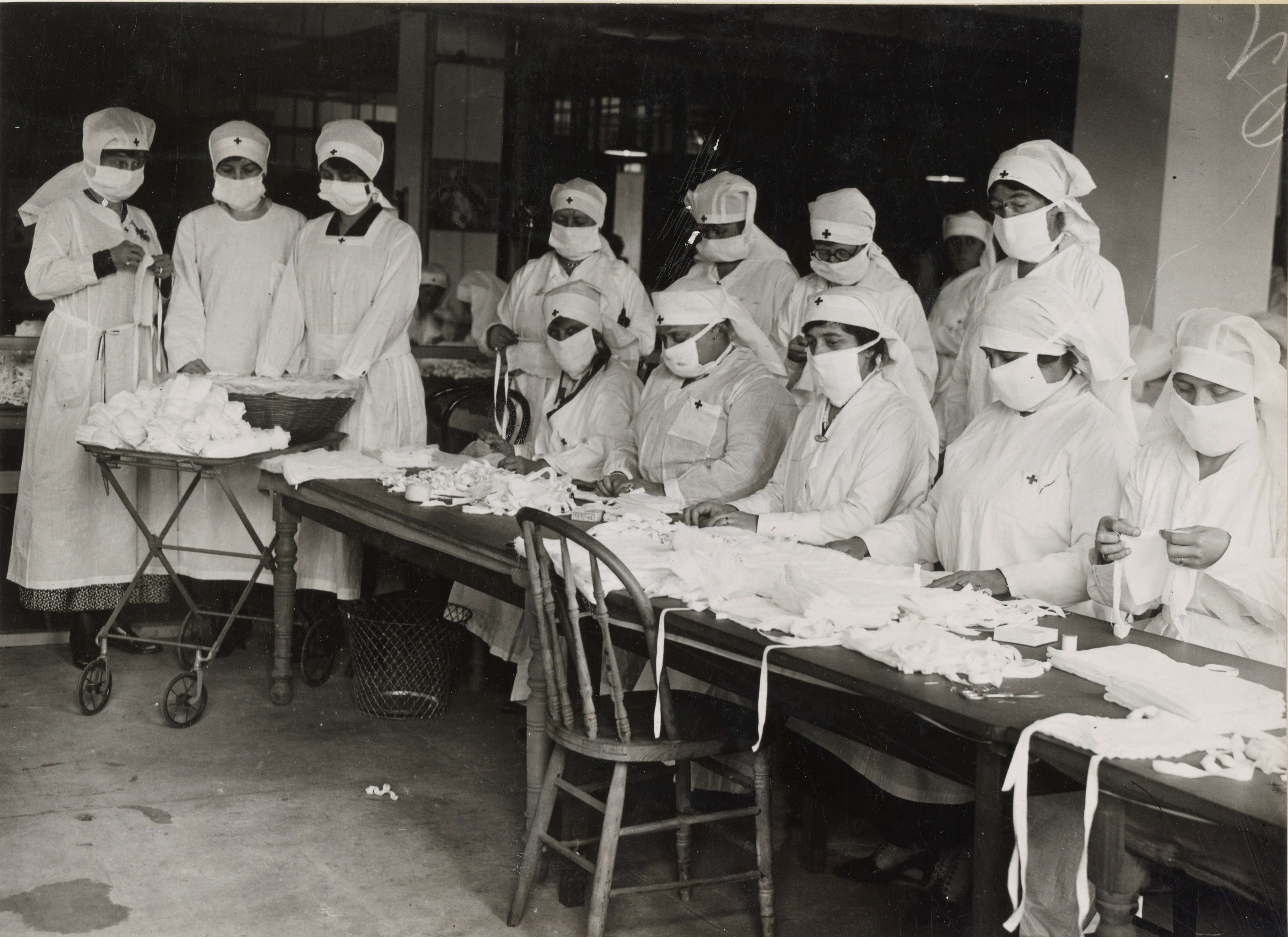
Document
Medical Department - Influenza Epidemic 1918 - Love Field, Dallas, Texas. Preventive treatment against influenza, spraying the throat
1917 - 1918
In this photograph, a man at Love Field in Dallas, Texas, is having his throat sprayed as a preventive treatment against influenza.
The 1918 Influenza Pandemic, also known as the Spanish Flu, was one of the deadliest events in human history. One fifth of the world's population was attacked. The epidemic killed an estimated 50 million people around the world – more than died in World War I. Within months, the deadly flu virus had killed more people than any other illness in recorded history.
Scientists, doctors, and health officials could not identify this disease which was striking so fast and so viciously, eluding treatment and defying control. Some victims died within hours of their first symptoms. Others succumbed after a few days; their lungs filled with fluid and they suffocated to death. The flu did not discriminate. It was rampant in urban and rural areas, from the densely populated East coast to the remotest parts of Alaska. Young adults, usually unaffected by these types of infectious diseases, were among the hardest hit groups along with the elderly and young children. The flu afflicted over 25 percent of the U.S. population.
The 1918 Influenza Pandemic, also known as the Spanish Flu, was one of the deadliest events in human history. One fifth of the world's population was attacked. The epidemic killed an estimated 50 million people around the world – more than died in World War I. Within months, the deadly flu virus had killed more people than any other illness in recorded history.
Scientists, doctors, and health officials could not identify this disease which was striking so fast and so viciously, eluding treatment and defying control. Some victims died within hours of their first symptoms. Others succumbed after a few days; their lungs filled with fluid and they suffocated to death. The flu did not discriminate. It was rampant in urban and rural areas, from the densely populated East coast to the remotest parts of Alaska. Young adults, usually unaffected by these types of infectious diseases, were among the hardest hit groups along with the elderly and young children. The flu afflicted over 25 percent of the U.S. population.
This primary source comes from the Records of the War Department General and Special Staffs.
National Archives Identifier: 45499289
Full Citation: Photograph 165-WW-269B-1; Medical Department - Influenza Epidemic 1918 - Love Field, Dallas, Texas. Preventive treatment against influenza, spraying the throat; 1917 - 1918; Medical Department - Influenza Epidemic 1918; American Unofficial Collection of World War I Photographs, 1917 - 1918; Records of the War Department General and Special Staffs, ; National Archives at College Park, College Park, MD. [Online Version, https://www.docsteach.org/documents/document/spraying-throat-influenza-texas, April 25, 2024]Medical Department - Influenza Epidemic 1918 - Love Field, Dallas, Texas. Preventive treatment against influenza, spraying the throat
Page 1
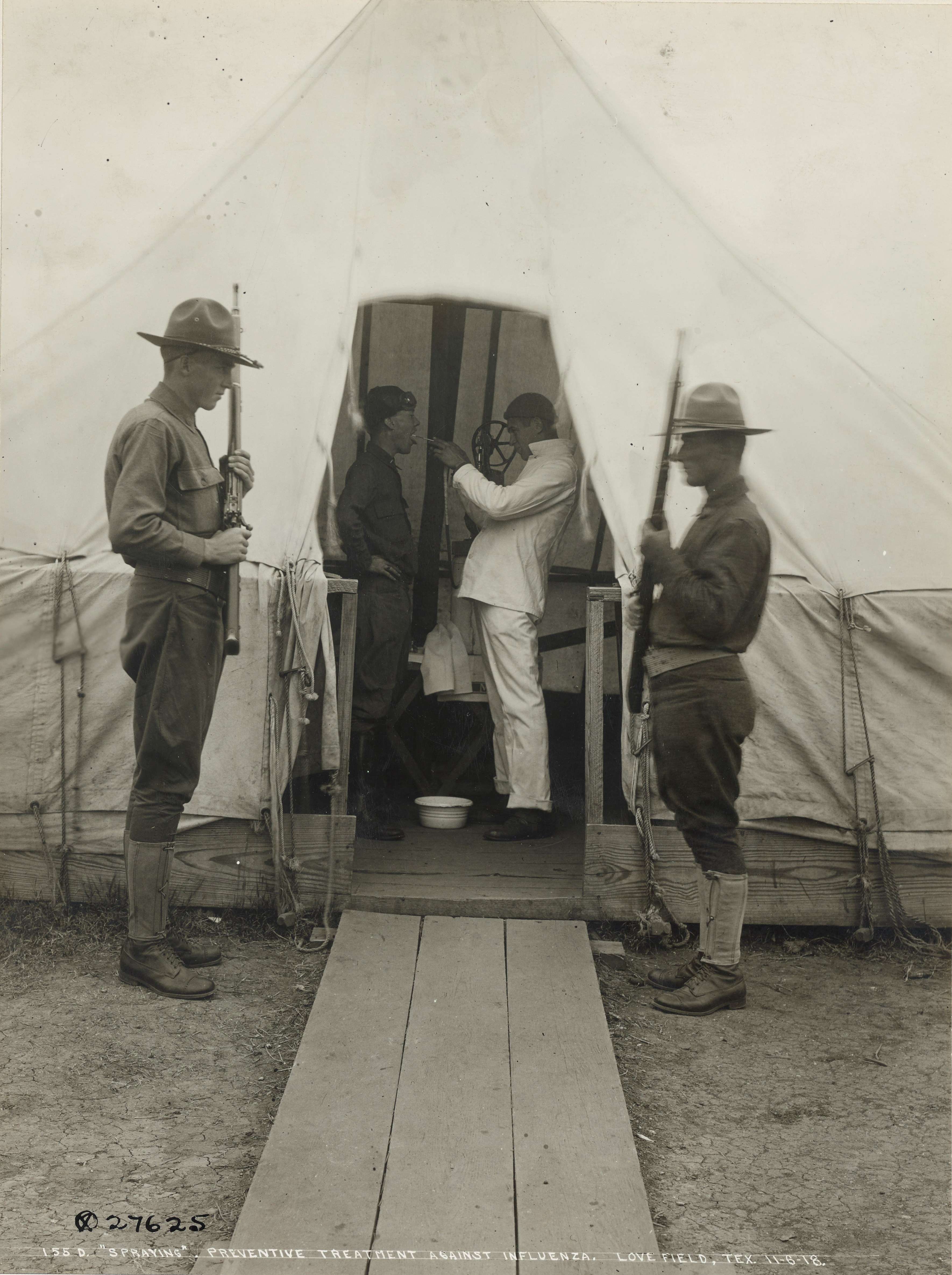
Document
Letter from Lutiant Van Wert to 'Louise'
10/17/1918
Former Haskell Institute student Lutiant Van Wert sent this letter to her friend Louise, who was still at the school. Van Wert describes her work as a volunteer nurse in Washington, DC, during the 1918 influenza epidemic. Other topics include social life and a rumor that German agents were responsible for the epidemic.
Haskell Institute was formed as a non-reservation Indian boarding school providing agricultural education and emphasizing assimilation in 1884. It later became a semi-military institution where students wore uniforms and marched to classes, then began offering college level classes in 1927.
Haskell Institute was formed as a non-reservation Indian boarding school providing agricultural education and emphasizing assimilation in 1884. It later became a semi-military institution where students wore uniforms and marched to classes, then began offering college level classes in 1927.
Transcript
(Copy)231-14th St. South East.
October 17, 1918.
Dear friend Louise:
So everybody has the "Flu" at Haskell? I wish to goodness Miss Keck and Mrs. McK. would get it and die with it. Really, it would be such a good riddance, and not much lost either! As many as 90 people die every day here with the "Flu". Soldiers too, are dying by the dozens. So far, Felicity, C. Zane, and I are the only ones of the Indian girls who have not had it. We certainly consider ourselves lucky too, believe me. Katherine and I just returned last Sunday evening from Camp Humphreys "Somewher in Virginia" where we volunteered to help nurse soldiers sick with the Influenza. We were there at the Camp ten days among some of the very worse cases and yet we did not contract it. We had intended staying much longer that we did, but the work was entirely too hard for us, and anyway the soldiers were all getting better, so we came home to rest up a bit. We were day nurses and stationed in the Officer's barracks for six days and then transferred to the Private's barracks or hospital and were there four days before we came back. All nurses were required to work twelve hours a day--we worked from seven in the morning until seven at night, with only a short time for luncheon and dinner.
-2-
Believe me, we were always glad when night came because we sure did get tired. We had the actual Practical nursing to do--just like the other nurses had, and were given a certain number of wards with three or four patients in each of them to look after. Our chief duties were to give medicines to the patients, take temperatures, fix ice packs, feed them at "eating time", rub their back or chest with camphorated sweet oil, make egg-nogs, and a whole string of other things I can't begin to name. I liked the work just fine, but it was too hard, not being used to it. When I was in the Officer's barracks, four of the officers of whom I had charge, died. Two of them were married and called for their wife nearly all the time. It was sure pitiful to see them die. I was right in the wards alone with them each time, and Oh! The first one that died sure unnerved me--I had to go to the nurses' quarters and cry it out. The other three were not so bad. Really, Louise, Orderlies carried the dead soldiers out on stretchers at the rate of two every three hours for the first two days were there. Two German spies, posing as doctors, were caught giving these Influenza germs to the soldiers and they were shot last Saturday at sunrise. It is such a horrible thing, it is hard to believe, and yet such things happen almost every day in Washington.
-3-
Repeated calls come from the Red Cross for nurses to do district work right here in D. C. I volunteered again, but as yet I have not been called and am waiting. Really, they are certainly "hard up" for nurses--even me can volunteer as a nurse in a camp or in Washington. There are about 800 soldiers stationed at Potomac Park right her in D. C. just a short distance from the Interior building where I work, and this morning's paper said that the deaths at this Park were increasing, so if fortune favors me, I may find myself there before the week is ended. I have a very dear soldier friend who is stationed there--Lieut. Cantril by name. "Twas so funny how we first met.
I was completely lost in St. Louis at the Union station (On my way to D. C.) and simply had no idea where I was going--just wandering around the station to pass away my 3 1/2 hrs. there waiting for my train. Finally, I thought of sending Odile a telegram so she could be at the station to meet me. I went to the Postal office right there in the Station and this soldier was standing there waiting to send a telegram too. I waited, waited, and waited and could not get in to send one, so I picked up my suit case and traveling bag and started towards the Ladies' Waiting room. Instead of taking my own traveling bag, I left mine and picked up this soldier's bag. They were as much alike as two peas, and
-4-
I was so tired I never took special notice, but I thought I had my own bag. When I opened it to get out my comb and powder--behold! There was a kit-bag fully equiped and a knitted sweater in it, plus a few other trinkets'. I knew then, whose aag I had, so checked my suit case and started out to look for this soldier and exchange bags, as I thought he had mine. After walking around 45 minutes I began to despair of ever finding him and started back to the Ladies room and I came upon him sitting in one corner. I recognized my bag right away and went to exchange. He was simply so tickled to get his bag back he almost squeezed the life out of my hand when he shook it. I had my card and destination tacked on the handle fo my bag, so he found out where I was going without telling him--and as fate would have it--he was going to D. C. too, so we traveled the rest of the way together. He is a perfect gentlemen, and sure treated me nice on the way. Since I am located here, he has been down to our house twice to see me since I came back from Camp Humphreys, and he sure wants me to come down to Potomac Park as a nurse. He is not what one would call "handsome" but he is certainly good-looking, and on top of all that--he is a CATHOLIC. Sure like it for myself too. All the girls have soldiers--Indian girls also. Some of the girls have soldiers and sailors too. The boys are particularly crazy about the Indian girls. They tell us that the Indian girls are not so "easy" as the white girls, so I guess maybe that's their reason.
-5-
Washington is certainly a beautiful place. There is so much to be said in favor of it, that if I started, I dont believe I should ever get through. Odile and I have to pass by the Capitol, the Union Station, the War Department, the Pension Bldg., and through the noted Lincoln park every morning to our way to work. The Washington Monument (555ft. high) is within walking distance of the Interior Department (where we work) and we walked there last evening after work, It certainly is high and we are planning to go up in the elevator some time to look over the city. We were going last evening, but the place is closed temporarily, on account of this "Flu".
The Aviation field is another very interesting place. her. Air-plaines fly over the city at all hours of the day now, and sometimes so low that one can hear the noise of the machine.
Besides Aviators, we have hundreds of soldiers, sailors, Marines, French "Blue Devils" and even the National band of Italy her in Washington. Douglas Fairbanks and Geraldine Farrar are here also on the fourth Liberty Loan campaign and I was privileged to take a chance to peep at them. Just yesterday, Douglas sold ONE MILLION DOLLARS WORTH OF BONDS FOR WASHINGTON. It was rumoured that Washington was going to fail to reach its quota in Liberty Bonds on account of having so many deaths and sick people in the city, but the way "Doug" is selling 'em, it doesn't seem as if it will.
-5-
Washington is certainly as
-6-
A lot of the girls from the Office here go out to sell bonds but some of them dont make much of a success. One of the Indian girls, named Cathryne Welch, went out last week to sell bonds and she sold so many that she got escused from the Office for the rest of this week to do nothing but sell bonds. She is a very pretty girl--a high school graduate and one year normal. She has two brothers in the army--one is a Captain and the other a Sargeant. Maybe you remember seeing Capt. Gus Welch's picture in the K. C. Star--well that is her brother and he is "over there" now.
All the schools, churches, theaters, dancing halls, etc. are closed here also. There is a bill in the Senate today authorizing all the war-workers to be released from work for the duration of this epidemic. It has not passed the house yet, but I can't help but hope it does. If it does, Lutiant can find plenty of things at home to busy herself with, or she might accidentally take a trip to Potomac Park. Ha! Ha!
It is perfectly alright about the sweater. I dont expect you to be able to get it while you are quartined, but will still be glad to have it if you can send it as soon as you are out of quartined. It is rather cold in Washington, but not cold enough to wear winter coats yet, and my suit coat is a little too thin, so I figured out that a sweater would be the thing to have. Sometimes it is cold enough to wear a wrap while working, but of course it is out of question
-7-
to work in a heavy winter coat. However, send it whenever you find it convenient to do so, and I will settle with you as promptly as possible.
Well Louise, if you are not dead tired of reading this letter, I'll write another like it some other time. There is still a lot I could tell you about D. C., but it's nearing lunch time and I want to be right ther on the dot, as I always am--to be sure.
Write again whenever you fine it convenient to do so--always glad to hear the Haskell news from you.
Sincerely your friend,
(Signed) Lutiant.
Address same as before.
This primary source comes from the Records of the Bureau of Indian Affairs.
National Archives Identifier: 2641556
Full Citation: Letter from Lutiant Van Wert to 'Louise'; 10/17/1918; Contagious Epidemics; Subject Correspondence Files, 1904 - 1941; Records of the Bureau of Indian Affairs, ; National Archives at Kansas City, Kansas City, MO. [Online Version, https://www.docsteach.org/documents/document/vanwert-to-louise, April 25, 2024]Letter from Lutiant Van Wert to 'Louise'
Page 1

Letter from Lutiant Van Wert to 'Louise'
Page 2
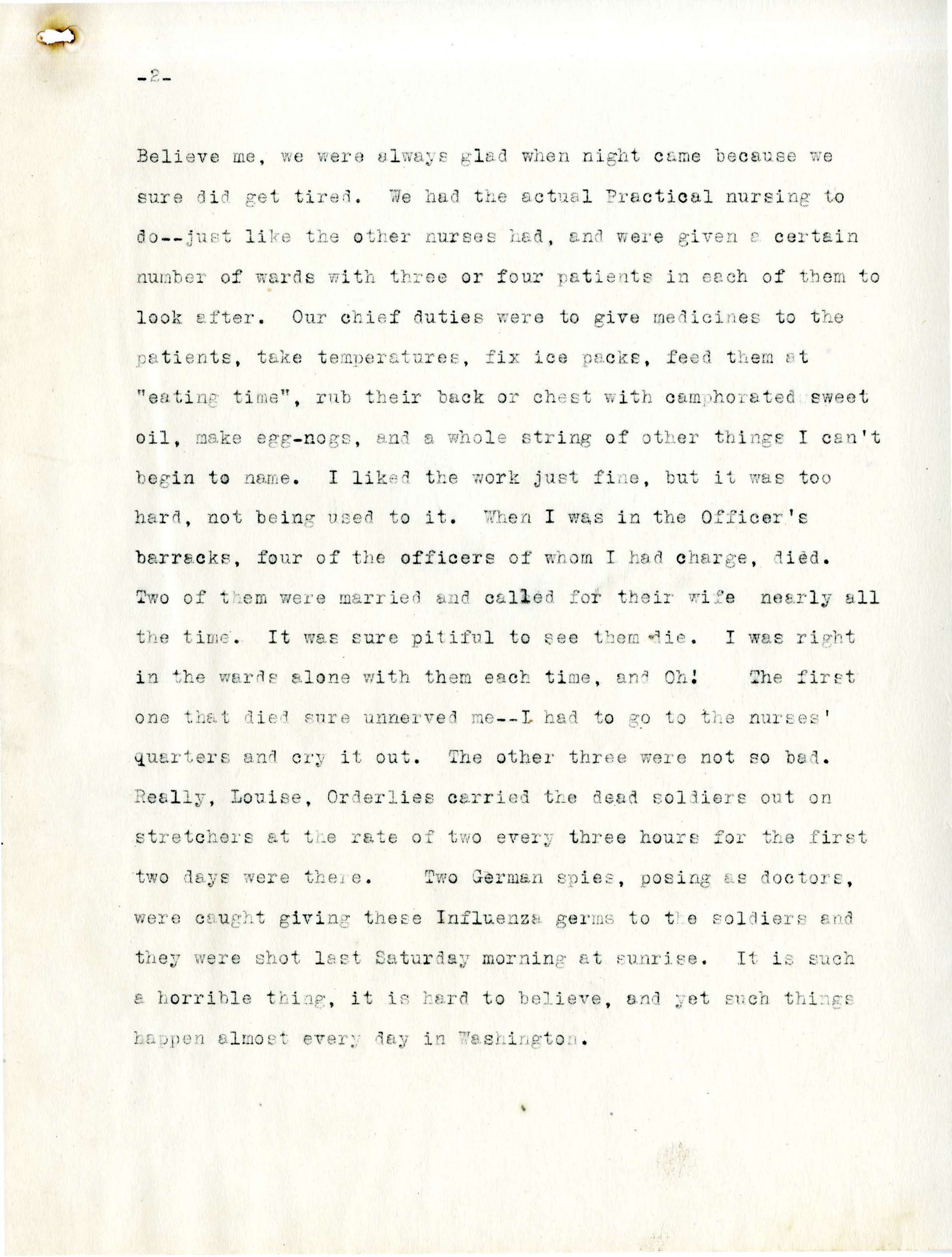
Letter from Lutiant Van Wert to 'Louise'
Page 3
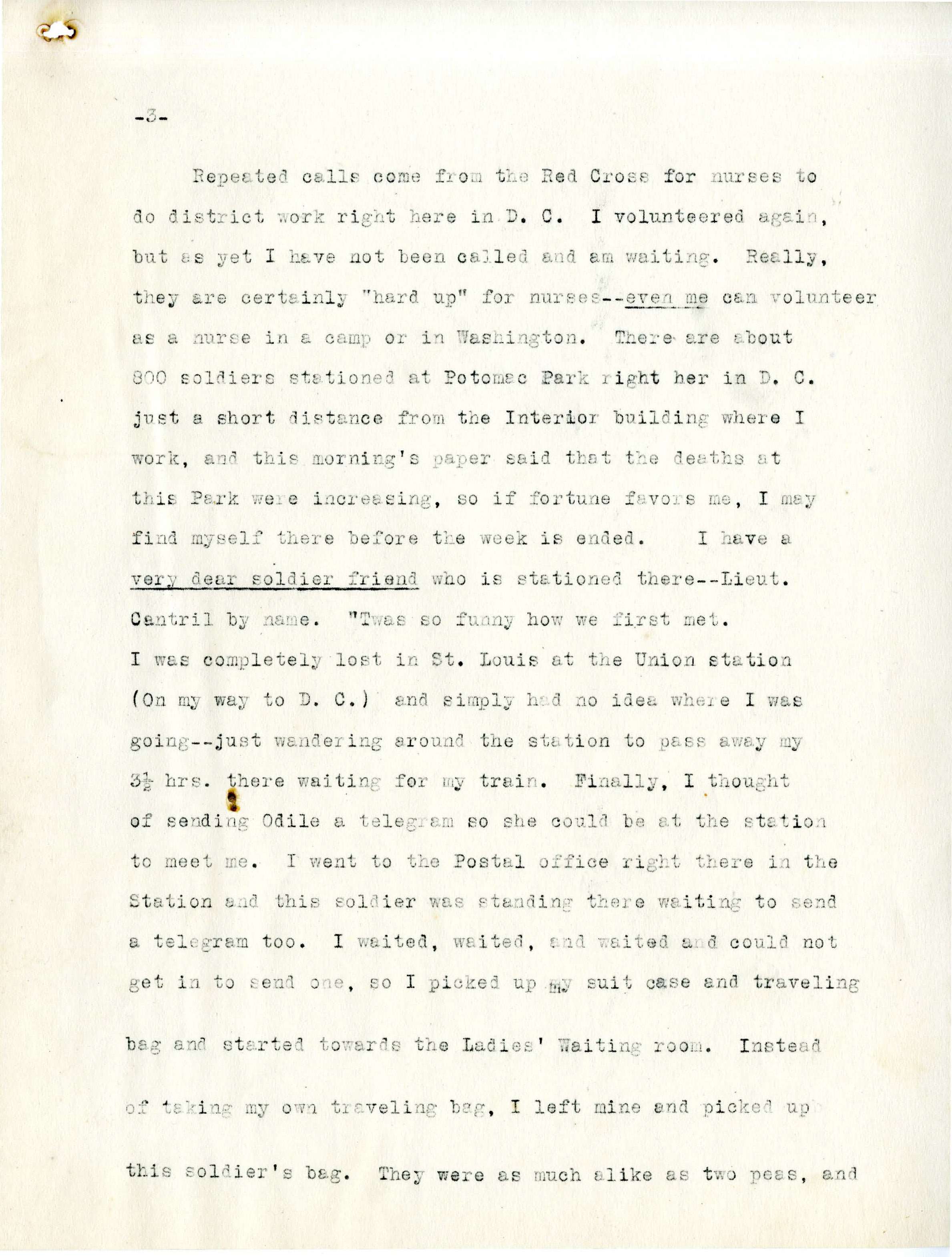
Letter from Lutiant Van Wert to 'Louise'
Page 4

Letter from Lutiant Van Wert to 'Louise'
Page 5
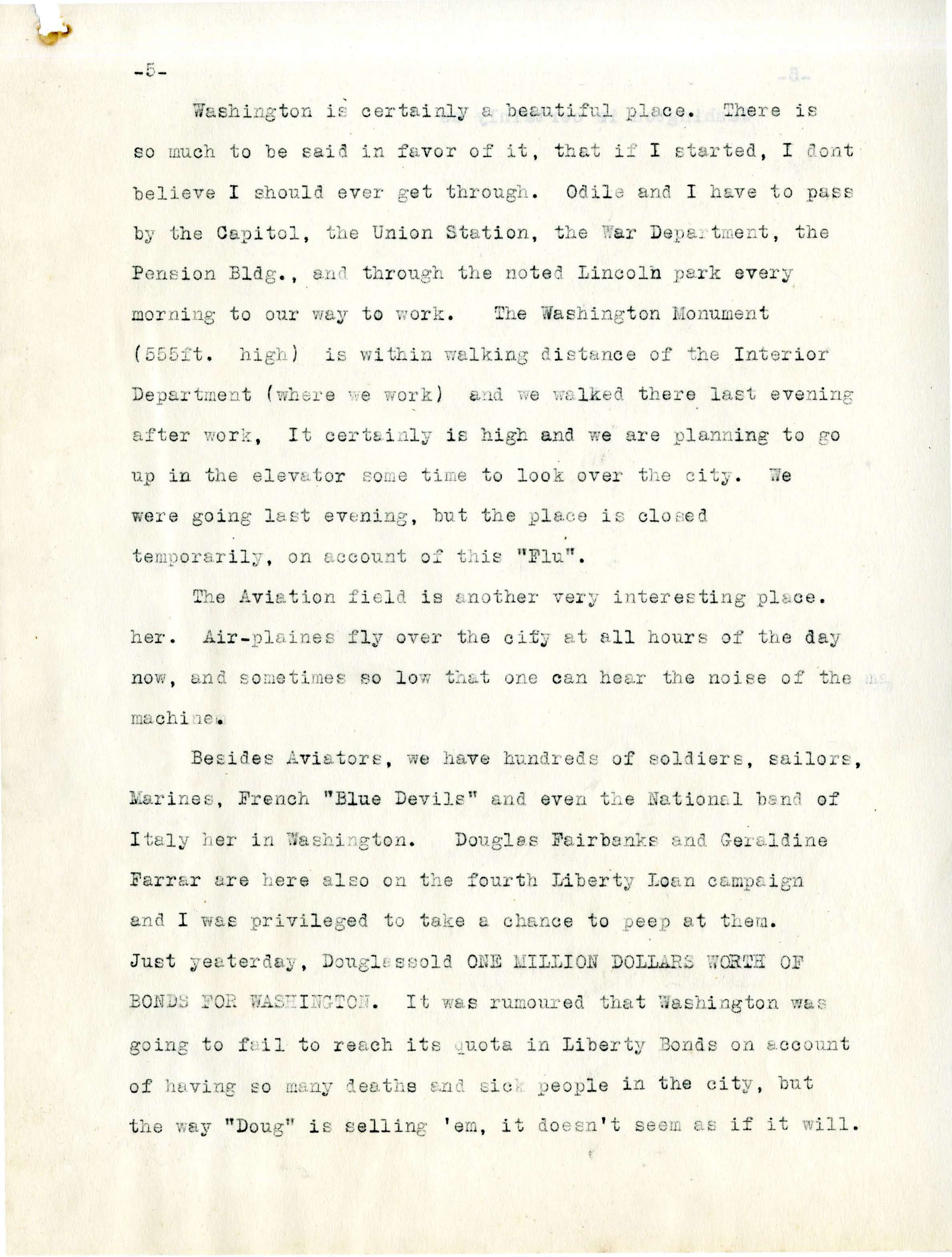
Letter from Lutiant Van Wert to 'Louise'
Page 6

Letter from Lutiant Van Wert to 'Louise'
Page 7
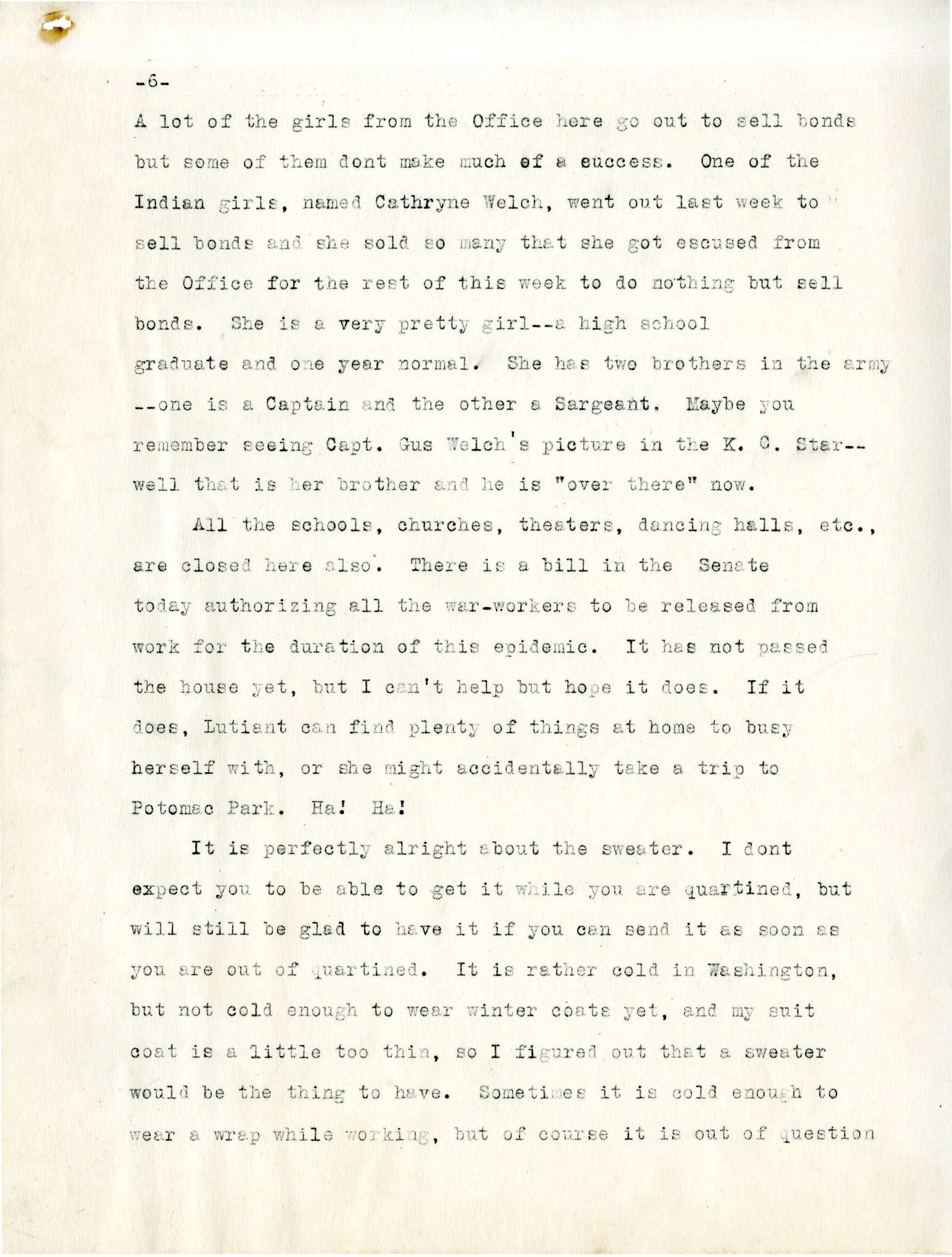
Letter from Lutiant Van Wert to 'Louise'
Page 8

Document
Medical Department - Influenza Epidemic 1918 - Influenza epidemic impedes war progress. Trolley car windows were kept open to prevent the spread of Spanish Influenza which did much to slow up war progress in this country. This photo was taken in Cinc
11/8/1918
This photograph was taken in Cincinnati, Ohio and shows a poster in a trolley car window encouraging the practice of keeping windows open to prevent the spead of the Spanish Influenza. This practice of keeping windows open was nationwide. The Spanish Influenza did much to slow up war progress in the United States.
The 1918 Influenza Pandemic, also known as the Spanish Flu, was one of the deadliest events in human history. One fifth of the world's population was attacked. The epidemic killed an estimated 50 million people around the world – more than died in World War I. Within months, the deadly flu virus had killed more people than any other illness in recorded history.
Scientists, doctors, and health officials could not identify this disease which was striking so fast and so viciously, eluding treatment and defying control. Some victims died within hours of their first symptoms. Others succumbed after a few days; their lungs filled with fluid and they suffocated to death. The flu did not discriminate. It was rampant in urban and rural areas, from the densely populated East coast to the remotest parts of Alaska. Young adults, usually unaffected by these types of infectious diseases, were among the hardest hit groups along with the elderly and young children. The flu afflicted over 25 percent of the U.S. population.
Scientists, doctors, and health officials could not identify this disease which was striking so fast and so viciously, eluding treatment and defying control. Some victims died within hours of their first symptoms. Others succumbed after a few days; their lungs filled with fluid and they suffocated to death. The flu did not discriminate. It was rampant in urban and rural areas, from the densely populated East coast to the remotest parts of Alaska. Young adults, usually unaffected by these types of infectious diseases, were among the hardest hit groups along with the elderly and young children. The flu afflicted over 25 percent of the U.S. population.
This primary source comes from the Records of the War Department General and Special Staffs.
National Archives Identifier: 45499333
Full Citation: Photograph 165-WW-269B-22; Medical Department - Influenza Epidemic 1918 - Influenza epidemic impedes war progress. Trolley car windows were kept open to prevent the spread of Spanish Influenza which did much to slow up war progress in this country. This photo was taken in Cinc; 11/8/1918; Medical Department - Influenza Epidemic 1918; American Unofficial Collection of World War I Photographs, 1917 - 1918; Records of the War Department General and Special Staffs, ; National Archives at College Park, College Park, MD. [Online Version, https://www.docsteach.org/documents/document/window-open-influenza-poster-trolley, April 25, 2024]Medical Department - Influenza Epidemic 1918 - Influenza epidemic impedes war progress. Trolley car windows were kept open to prevent the spread of Spanish Influenza which did much to slow up war progress in this country. This photo was taken in Cinc
Page 1

Document
Medical Department - Influenza Epidemic 1918 - Emergency hospital, Brookline, Massachusetts, to care for influenza cases
10/1918
This photograph shows an emergency hospital at Brookline, Massachusetts to care of influenza patients.
The 1918 Influenza Pandemic, also known as the Spanish Flu, was one of the deadliest events in human history. One fifth of the world's population was attacked. The epidemic killed an estimated 50 million people around the world – more than died in World War I. Within months, the deadly flu virus had killed more people than any other illness in recorded history.
Scientists, doctors, and health officials could not identify this disease which was striking so fast and so viciously, eluding treatment and defying control. Some victims died within hours of their first symptoms. Others succumbed after a few days; their lungs filled with fluid and they suffocated to death. The flu did not discriminate. It was rampant in urban and rural areas, from the densely populated East coast to the remotest parts of Alaska. Young adults, usually unaffected by these types of infectious diseases, were among the hardest hit groups along with the elderly and young children. The flu afflicted over 25 percent of the U.S. population.
The 1918 Influenza Pandemic, also known as the Spanish Flu, was one of the deadliest events in human history. One fifth of the world's population was attacked. The epidemic killed an estimated 50 million people around the world – more than died in World War I. Within months, the deadly flu virus had killed more people than any other illness in recorded history.
Scientists, doctors, and health officials could not identify this disease which was striking so fast and so viciously, eluding treatment and defying control. Some victims died within hours of their first symptoms. Others succumbed after a few days; their lungs filled with fluid and they suffocated to death. The flu did not discriminate. It was rampant in urban and rural areas, from the densely populated East coast to the remotest parts of Alaska. Young adults, usually unaffected by these types of infectious diseases, were among the hardest hit groups along with the elderly and young children. The flu afflicted over 25 percent of the U.S. population.
This primary source comes from the Records of the War Department General and Special Staffs.
National Archives Identifier: 45499327
Full Citation: Medical Department - Influenza Epidemic 1918 - Emergency hospital, Brookline, Massachusetts, to care for influenza cases; 10/1918 ; Photograph 165-WW-269B-19; Medical Department - Influenza Epidemic 1918; American Unofficial Collection of World War I Photographs, 1917 - 1918; Records of the War Department General and Special Staffs, ; National Archives at College Park, College Park, MD. [Online Version, https://www.docsteach.org/documents/document/emergency-hospital-brookline-massachusetts-influenza, April 25, 2024]Medical Department - Influenza Epidemic 1918 - Emergency hospital, Brookline, Massachusetts, to care for influenza cases
Page 1
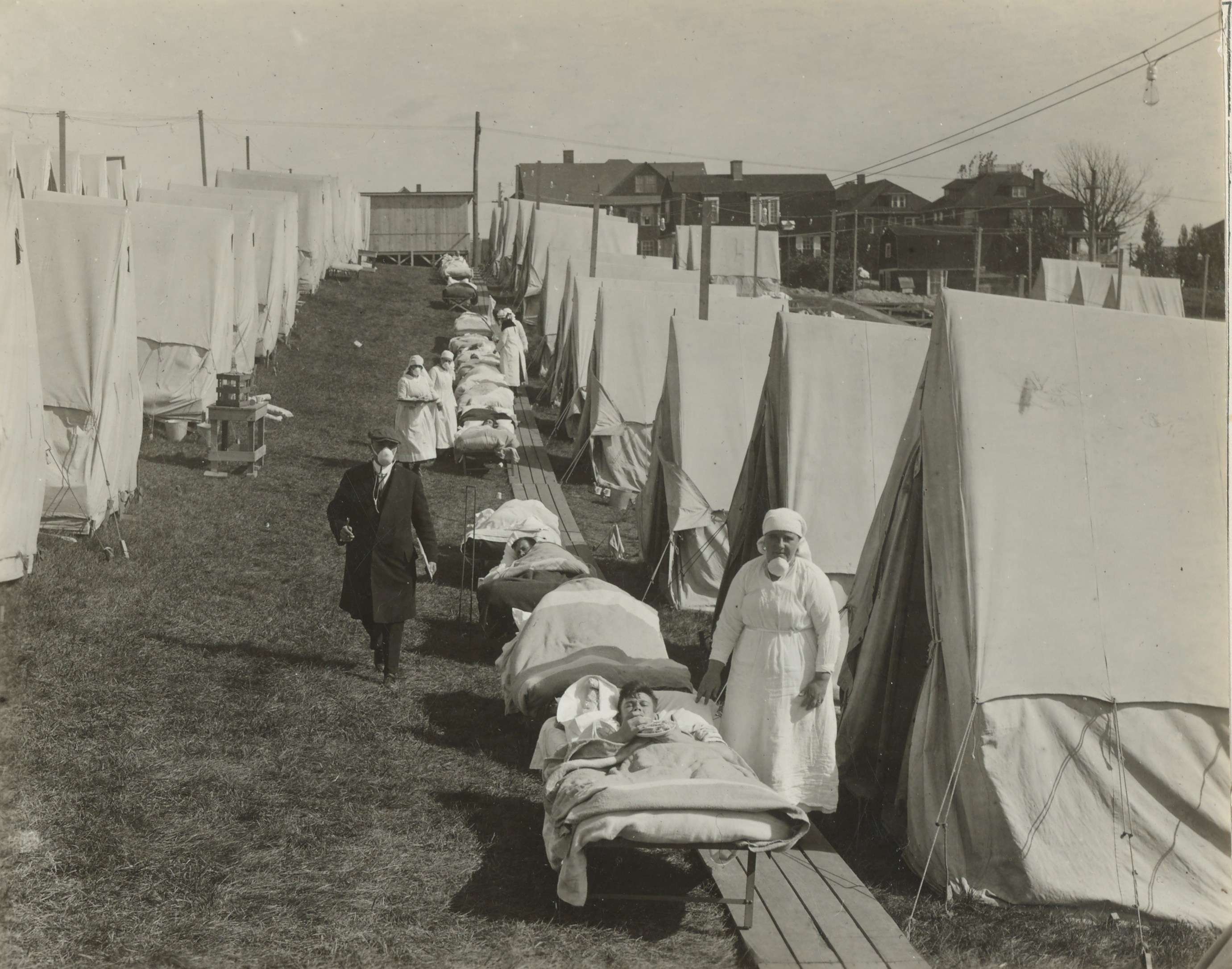
Document
Letter from Harry S. Truman to Bess Wallace
1/21/1919
Truman's letter includes references to the deadly influenza epidemic that followed World War I. He expresses his relief that Bess has recovered from the flu, and tells her that he has carried her picture (the one she sent him at Camp Doniphan) with him throughout the war. He says that he is eager to come home and wishes that the "ex-mayor of Toledo" (Secretary of War Newton Baker, who was actually an ex-mayor of Cleveland) would arrange this; along with the other American soldiers, he does not care about the peace plans of "Woodie" (President Woodrow Wilson) or European political struggles. He also alludes to the adoption of Prohibition in the United States, commenting that he wants to get back home and "lay in a supply for future consumption."
Transcript
Knights of ColumbusOverseas Service
On Active Service with American Expeditionary Forces
A.P.O. Camp La Beholle near Verdun
Date Jan. 21 1919
Dear Bess:-
Your grand letter of Dec 26 came last night and of course I was as happy as a kid with a bonbon, I am so glad you had a happy white Christmas. It is a good omen I'm sure and I sincerely hope that "flu" will be an unheard of ailment from this time forward. Your point is well taken regarding the furniture in my room at the Hotel Medeterranee (can't spell it). It would of course be essential to provide either a place to eat or a range. I am very sure that I shouldn't have overlooked a vital point like that even if I am blinded by Eros. My experiences to date have taught me most emphatically that it is very very essential that food be provided in plentiful quantities even if clothing has to be overlooked sometimes. Some of my men have been pretty close to nature at various times as to clothes but if there happened to be plenty of roast beef and baked beans it was
a happy lunch. But leave off the eats for a meal or two and it made one "h- of a mean man" to put it as they do. Therefore I won't overlook that end of it nor any other I hope. The stationary George and May gave you is simply grand and it makes me sorry to have to answer it on this kind but even this hand is at a high premium here. I think May's picture is pretty fine myself. You know I have two breast pockets in my blouse. Naturally you can guess whose picture stays in the left hand one. I keep May's and Mamma's in the other. Yours is the one you sent me at Doniphon and it has never left me from that day to this nor will it ever. It's been through all the trials and tribulations and happy moments same as I have. I have looked at it many many times and imagined that you were there in spirit as I know you were and its helped a lot especially when things were blue and it would look as if I'd surely blow up if another thing went wrong. I've never blown up and my disposition isn't so very bad. That picture saved it. The biggest worry I've ever had was when I heard that the original of that picture had the "flu" and the happiest day was when that letter came saying you'd walked up
Knights of Columbus
Overseas Service
On Active Service with American Expeditionary Forces
APO
DATE
town. I am hoping that Nice will not be an impossibility to us and I don't believe it will. You did right to send your proxy to Boxley. He's to be trusted absolutely.
We are having another spasm of moving. There have been orders out twice to move up back to a dirty little old French village but each time Gen. Berry has been able to get them canceled, because we have better quarters here than we can possibly get in a town. I suppose though that we'll go this time. Heard a real good rumor the other day. To show you how they start I'll just trace this one for you. An ordinance sergeant (get that ordAnance) who was overhauling F.Bty's guns told the Lt. who went after them that his own commanding officer, a Lt. had been told by the Generals aide that our guns were being overhauled so that they could be turned in at Le Mans on
Jan 27 which happens to be the Kaiser's birthday (so he said) and then we'd all go home. Now the whole foundation for that nice tale was the definite order for us to move back to a little old village and be billeted not far from Bar-le-Duc and about 40 miles from here. It's my opinion that we'll stay there until Woodie gets his pet peace plans refused or OKed. For my part, and every AEF man feels the same way, I don't give a whoop (to put it mildly) whether there's a league of nations or whether Russia has a Red Government or a Purple one and if the President of the Czechs-Slavocs wants to pry the throne from under the King of Bohemia let him pry but send us home. We came over here to help whip the Hun. We helped a little, the Hun yowled for peace and he's getting in in large doses and if our most excellent ex mayor of Toledo wants to make a hit with us he'll hire or buy some ships and put the Atlantic Ocean between us and the Vin Rouge Sea. For my part I've had enough Vin Rouge and Frogeater victuals to last me a lifetime. And anyway it looks to me like the moon shine business is going to be pretty good in the land of Liberty Loans and Green Trading stamps and some of us want to get in on
Knights of Columbus
Overseas Service
On Active Service with American Expeditionary Forces
APO
DATE
the ground floor. At least we want to get there in time to buy in a supply for future consumption. I think a quart of Bourbon would last me about forty years.
I hope you have a most happy birthday and that you never see another one without me to help celebrate and then may they go on without end. Remember me to your mother and Fred and Frank and Natalie and George and May and just keep writing when you feel inclined because I love you.
Always,
Harry
Harry Truman
Capt. Bty D129 Fa
American E.F.
Overseas Service
On Active Service with American Expeditionary Forces
APO
DATE
the ground floor. At least we want to get there in time to buy in a supply for future consumption. I think a quart of Bourbon would last me about forty years.
I hope you have a most happy birthday and that you never see another one without me to help celebrate and then may they go on without end. Remember me to your mother and Fred and Frank and Natalie and George and May and just keep writing when you feel inclined because I love you.
Always,
Harry
Harry Truman
Capt. Bty D129 Fa
American E.F.
This primary source comes from the Collection HST-FBP: Harry S. Truman Papers Pertaining to Family, Business and Personal Affairs.
National Archives Identifier: 200650
Full Citation: Letter from Harry S. Truman to Bess Wallace; 1/21/1919; Correspondence from Harry S. Truman to Bess Wallace Truman; Family Correspondence Files, 1910 - 1959; Collection HST-FBP: Harry S. Truman Papers Pertaining to Family, Business and Personal Affairs, ; Harry S. Truman Library, Independence, MO. [Online Version, https://www.docsteach.org/documents/document/harry-truman-to-bess-wallace, April 25, 2024]Letter from Harry S. Truman to Bess Wallace
Page 1
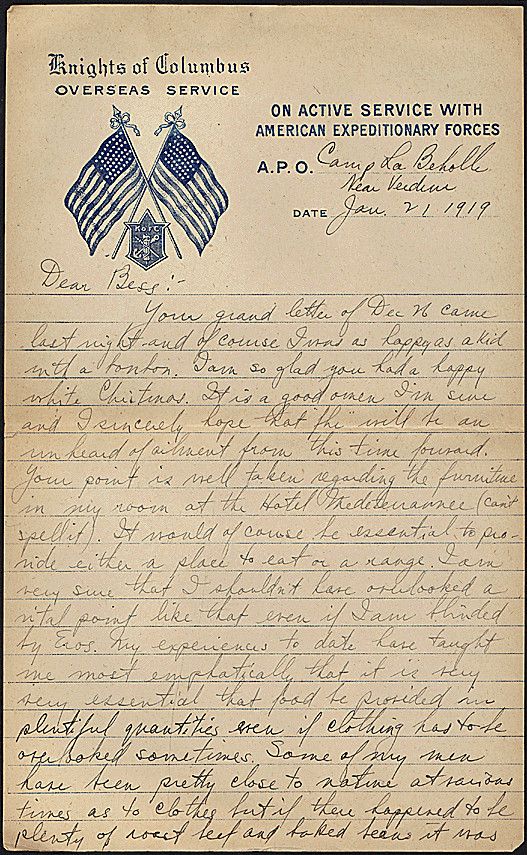
Letter from Harry S. Truman to Bess Wallace
Page 2

Letter from Harry S. Truman to Bess Wallace
Page 3
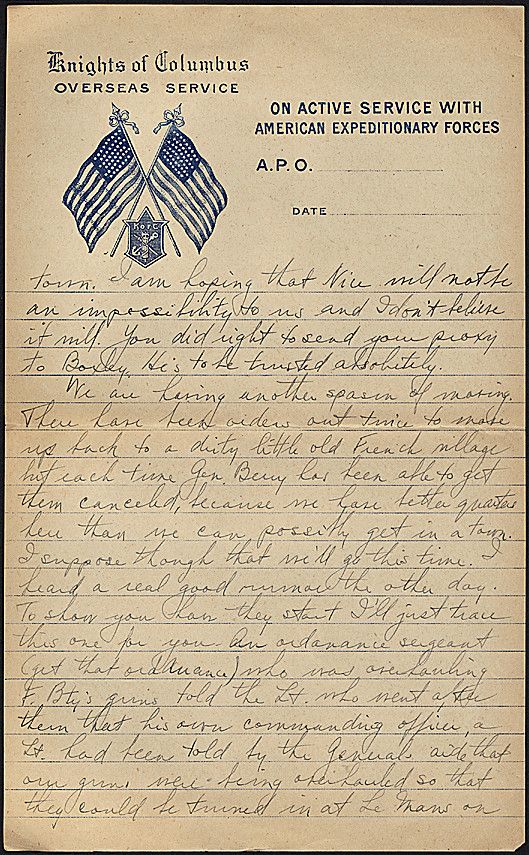
Letter from Harry S. Truman to Bess Wallace
Page 4

Letter from Harry S. Truman to Bess Wallace
Page 5
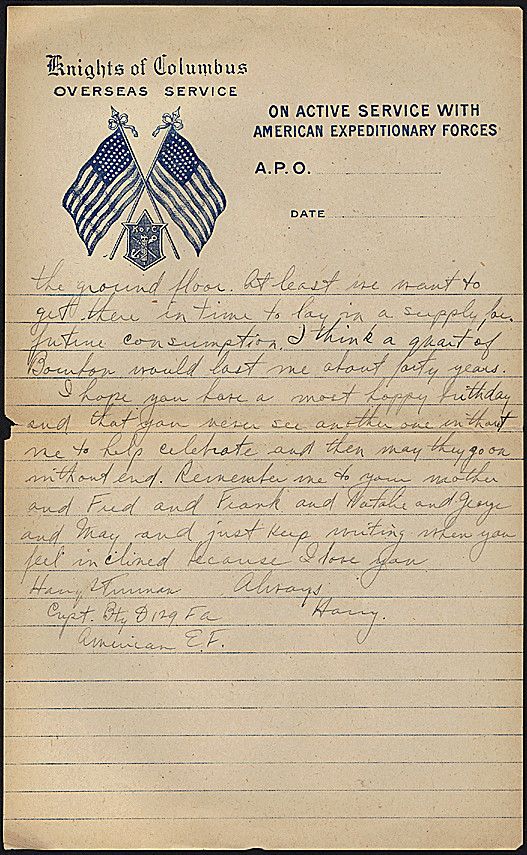
Document
The full caption for this item is as follows: American Red Cross canteens, United States. Taking food to the [African American] family all down with the 'Flu'
ca. 1917 -1919
The full caption for this photograph reads: American Red Cross canteens, United States. Taking food to the [African American] family all down with the "Flu" at Charlotte, North Carolina. They found the mother had just died. Mrs. Ralph Van Landingham, Mrs. Camson Morrison, Miss Julia Baxter Scott.
This primary source comes from the Records of the War Department General and Special Staffs.
National Archives Identifier: 533586
Full Citation: Photograph 165-WW-127(94); The full caption for this item is as follows: American Red Cross canteens, United States. Taking food to the [African American] family all down with the 'Flu'; ca. 1917 -1919; American Unofficial Collection of World War I Photographs, 1917 - 1918; Records of the War Department General and Special Staffs, ; National Archives at College Park, College Park, MD. [Online Version, https://www.docsteach.org/documents/document/red-cross-food-family, April 25, 2024]The full caption for this item is as follows: American Red Cross canteens, United States. Taking food to the [African American] family all down with the 'Flu'
Page 1
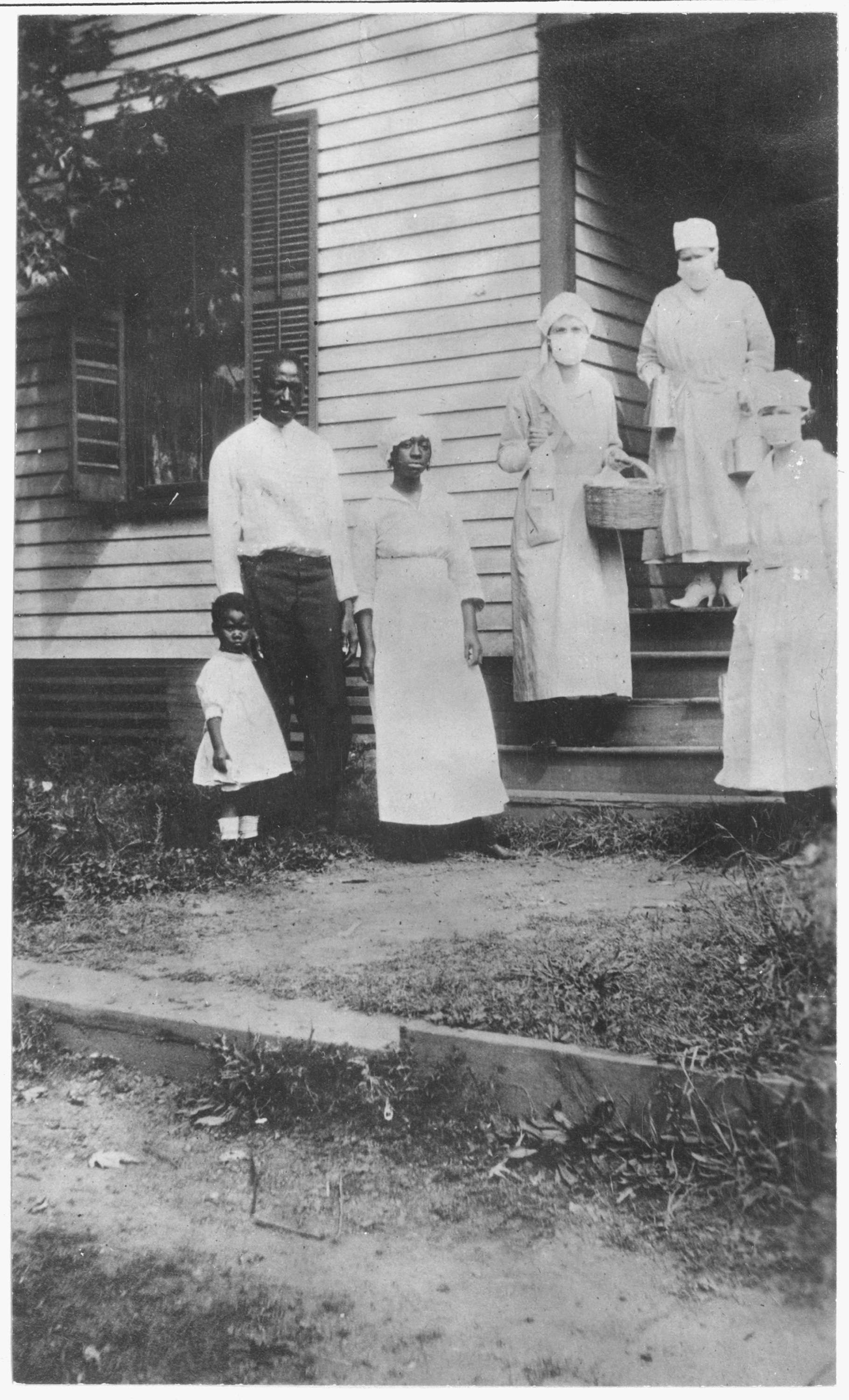
Document
Medical Department - Influenza Epidemic 1918 - Precautions taken in Seattle, Washington, during the Spanish Influenza epidemic would not permit any one to ride on the street cars without wearing a mask. The Red Cross made 260,000 masks
12/1918
This photograph shows precautions being taken in Seattle, Washington during the Spanish Influenza epidemic by not permitting anyone to ride on the street cars without wearing a mask. To assist with the high demand for masks the Red Cross produced 260,000 masks.
The 1918 Influenza Pandemic, also known as the Spanish Flu, was one of the deadliest events in human history. One fifth of the world's population was attacked. The epidemic killed an estimated 50 million people around the world – more than died in World War I. Within months, the deadly flu virus had killed more people than any other illness in recorded history.
Scientists, doctors, and health officials could not identify this disease which was striking so fast and so viciously, eluding treatment and defying control. Some victims died within hours of their first symptoms. Others succumbed after a few days; their lungs filled with fluid and they suffocated to death. The flu did not discriminate. It was rampant in urban and rural areas, from the densely populated East coast to the remotest parts of Alaska. Young adults, usually unaffected by these types of infectious diseases, were among the hardest hit groups along with the elderly and young children. The flu afflicted over 25 percent of the U.S. population.
The 1918 Influenza Pandemic, also known as the Spanish Flu, was one of the deadliest events in human history. One fifth of the world's population was attacked. The epidemic killed an estimated 50 million people around the world – more than died in World War I. Within months, the deadly flu virus had killed more people than any other illness in recorded history.
Scientists, doctors, and health officials could not identify this disease which was striking so fast and so viciously, eluding treatment and defying control. Some victims died within hours of their first symptoms. Others succumbed after a few days; their lungs filled with fluid and they suffocated to death. The flu did not discriminate. It was rampant in urban and rural areas, from the densely populated East coast to the remotest parts of Alaska. Young adults, usually unaffected by these types of infectious diseases, were among the hardest hit groups along with the elderly and young children. The flu afflicted over 25 percent of the U.S. population.
This primary source comes from the Records of the War Department General and Special Staffs.
National Archives Identifier: 45499311
Full Citation: Photograph 165-WW-269B-11; Medical Department - Influenza Epidemic 1918 - Precautions taken in Seattle, Washington, during the Spanish Influenza epidemic would not permit any one to ride on the street cars without wearing a mask. The Red Cross made 260,000 masks; 12/1918; Medical Department - Influenza Epidemic 1918; American Unofficial Collection of World War I Photographs, 1917 - 1918; Records of the War Department General and Special Staffs, ; National Archives at College Park, College Park, MD. [Online Version, https://www.docsteach.org/documents/document/seattle-washington-street-cars-passengers-masks-influenza, April 25, 2024]Medical Department - Influenza Epidemic 1918 - Precautions taken in Seattle, Washington, during the Spanish Influenza epidemic would not permit any one to ride on the street cars without wearing a mask. The Red Cross made 260,000 masks
Page 1
